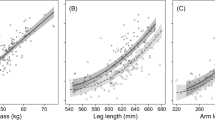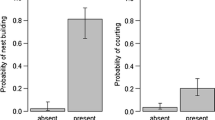Summary
Morphometric analyses and behavioral observations of a marked population of brood parasitic brown-headed cowbirds (Molothrus ater) revealed several male attributes correlated with dominance. Males that won larger percentages of the contests in which they were involved tended to be older and larger than other males. Dominant males arrived earlier on the breeding grounds and became engaged in more contests than subordinate males. If a female was present during a contest among males, the male which she was accompanying (her “consort”, and mate in most cases) was more likely to win the contest than were any of his opponents. Multiple regression analyses were performed to determine any significant partial effects of these attributes on male dominance. Age and involvement in more contests exerted significant partial effects in some analyses, but only the presence of a female consort did so consistently. I suggest that the female is a resource of greater value to the male with whom she is consorting than to other males. Her value is greater in terms of present and future benefits because he has already expended some or all of the effort necessary to establish a pair bond. He will have to expend less future effort to remain her mate than would another male to become her mate. Her presence during contests induces him to persist (or escalate) and to dominate his male opponents.
Similar content being viewed by others
References
Bachmann C, Kummer H (1980) Male assessment of female choice in hamadryas baboons. Behav Ecol Sociobiol 6:315–321
Barash DP (1982) Sociobiology and behavior. Elsevier, New York
Berry KH (1974) The ecology and social behavior of the chuckwalla, Sauromalus obesus obesus baird. Univ Calif Publ Zool, vol 101, pp 1–60
Bishop DT, Cannings C, Maynard Smith J (1978) The war of attrition with random rewards. J Theor Biol 74:377–388
Clutton-Brock TH, Albon SD (1979) The roaring of red deer and the evolution of honest advertisement. Behaviour 69:145–170
Darley JA (1982) Territoriality and mating behavior of the male brown-headed cowbird. Condor 84:15–21
Davies NB (1978) Territorial defense in the speckled wood butterfly (Pararge aegeria): the resident always wins. Anim Behav 26:138–147
Davies NB, Halliday TR (1978) Deep croaks and fighting assessment in toads Bufo bufo. Nature 274:683–685
Dufty AM (1982a) Movements and activities of radio-tracked brown-headed cowbirds. Auk 99:316–327
Dufty AM (1982b) Response of brown-headed cowbirds to simulated conspecific intruders. Anim Behav 30:1043–1052
Dufty AM (1986) Singing and the establishment and maintenance of dominance hierarchies in captive brown-headed cowbirds. Behav Ecol Sociobiol 19:49–55
Elliott PF (1980) Evolution of promiscuity in the brown-headed cowbird. Condor 82:138–141
Ewald PW (1985) Influence of asymmetries in resource quality and age on aggression and dominance in black-chinned hummingbirds. Anim Behav 33:705–719
Fleischer RC, Smyth AP, Rothstein SI (1987) Temporal and age-related variation in the laying rate of the parasitic brown-headed cowbird in the eastern Sierra Nevada, California. Can J Zool 65:2724–2730
Friedmann H (1929) The cowbirds, a study in the biology of social parasitism. Thomas, Springfield
Fugle GN, Osenberg CW, McGinley MA (1984) Signals of status in wintering white-crowned sparrows, Zonotrichia leucophrys gambelii. Anim Behav 32:86–93
Hammerstein P (1981) The role of asymmetries in animal contests. Anim Behav 29:193–205
Hyatt G, Salmon M (1978) Combat in the fiddler crabs Uca pugilator and U. pugnax: a quantitative analysis. Behaviour 65:182–211
James FC (1970) Geographic size variation in birds and its relationship to climate. Ecology 51:365–390
Jarman PJ (1983) Mating system and sexual dimorphism in large, terrestrial, mammalian herbivores. Biol Rev 58:485–520
Maynard Smith J (1974) The theory of games and the evolution of animal conflicts. J Theor Biol 47:209–221
Maynard Smith J, Parker GA (1976) The logic of asymmetric contests. Anim Behav 24:159–175
Maynard Smith J, Price GR (1973) The logic of animal conflict. Nature 246:15–18
Norman RF, Taylor PD, Robertson RJ (1977) Stable equilibrium strategies and penalty functions in a game of attrition. J Theor Biol 65:571–578
Parker GA (1974) Assessment strategy and the evolution of fighting behaviour. J Theor Biol 47:223–243
Rand A, Rand W (1976) Agonistic behaviour in nesting iguanas: a stochastic analysis of dispute settlement dominated by the minimization of energy cost. Z Tierpsychol 40:279–299
Riechert S (1978) Games spiders play: behavioral variability in teeritorial disputes. Behav Ecol Sociobiol 3:135–162
Robinson SK (1985) Fighting and assessment in the yellowrumped cacique (Cacicus cela) Behav Ecol Sociobiol 18:39–44
Rohwer S (1985) Dyed birds achieve higher social status than controls in harris' sparrows. Anim Behav 33:1325–1331
Rothstein SI, Fleischer RC (1987) Vocal dialects and their possible relation to honest status signalling in the Brownheaded Cowbird. Condor 89:1–23
Rothstein SI, Verner J, Stevens E (1980) Range expansion and diurnal changes in dispersion of the brown-headed cowbird in the Sierra Nevada. Auk 97:253–267
Rothstein SI, Verner J, Stevens E (1980) Radio-tracking confirms a unique diurnal pattern of spatial occurrence in the parasitic brown-headed cowbird. Ecology 65:77–88
Rothstein SI, Yokel DA, Fleischer RC (1986) Social dominance, mating and spacing systems, female fecundity and vocal dialects in captive and free-ranging brown-headed cowbirds. Curr Ornithol 3:127–185
Scott DM, Ankney CD (1983) Fecundity of the brown-headed cowbird in southern Ontario. Auk 97:677–683
Scott DM, Ankney CD (1983) The laying cycle of brown-headed cowbirds: passerine chickens? Auk 100:583–592
Searcy WA (1979) Sexual selection and body size in male redwinged blackbirds. Evolution 33:347–361
Selander RK, Giller DR (1960) First-year plumages of the brown-headed cowbird and red-winged blackbird. Condor 62:202–214
Silbaugh JM, Ewald PW (1987) Effects of unit pay-off asymmetries on aggression and dominance in meadow voles, Microtus pennsylvanicus. Anim, Behav 35:606–608
Sokal RR, Rohlf FJ (1981) Biometry. Freeman, San Francisco
Warner RR (1984) Deterred reproduction as a response to sexual selection in a coral reef fish: a test of the life historical consequences. Evolution 38:148–162
West MJ, King AP, Eastzer DH (1981) Validating the female bioassay of cowbird song: relating differences in song potency to mating success. Anim Behav 29:490–501
Woolbright LL (1983) Sexual selection and size dimorphism in anuran amphibia. Am Nat 121:110–119
Yokel DA (1986a) Monogamy and brood parasitism: an unlikely pair. Anim Behav 34:1348–1358
Yokel DA (1986b) The social organization of the brown-headed cowbird in the Owens Valley, California. In: Hall CA, Young DJ (eds) Natural history of the White-Inyo Range, eastern California and western Nevada and high altitude physiology: University of California, White Mountain Research Station Symposium. vol 1. Regents of the University of California, Los Angeles, pp 164–172
Yokel DA (1987) Sexual selection and the mating system of the brown-headed cowbird (Molothrus ater) in eastern California. Ph D diss, University of California, Santa Barbara, California, USA
Yokel DA (1989) Intrasexual aggression and the mating behavior of brown-headed cowbirds: their relation to population densities and sex ratios. Condor (in press)
Author information
Authors and Affiliations
Rights and permissions
About this article
Cite this article
Yokel, D.A. Payoff asymmetries in contests among male brown-headed cowbirds. Behav Ecol Sociobiol 24, 209–216 (1989). https://doi.org/10.1007/BF00295200
Received:
Accepted:
Issue Date:
DOI: https://doi.org/10.1007/BF00295200




